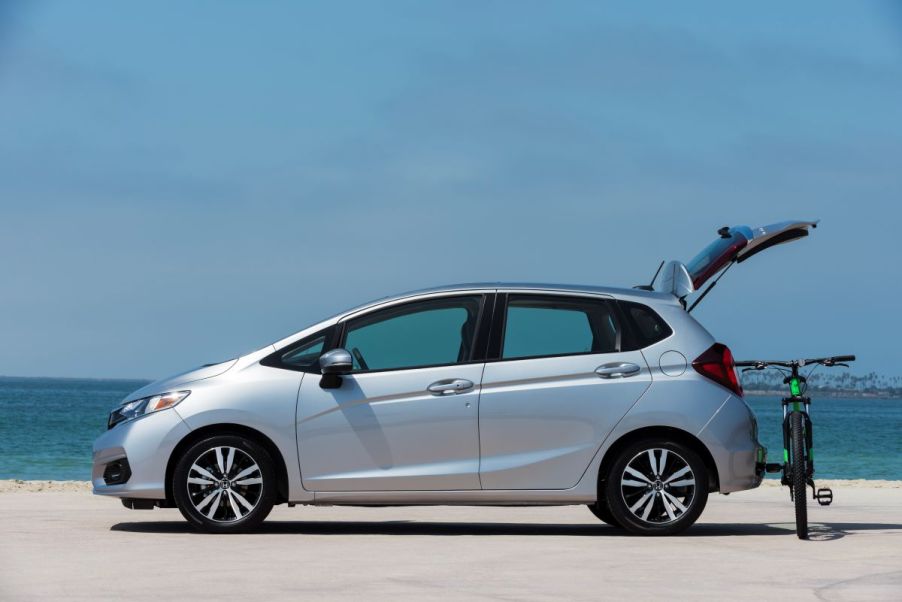
Maximize Your Budget With These 4 Best Used Honda Fit Model Years
Although the five-door, five-passenger Honda Fit is no longer in production, plenty are on the used market. With up to 52.7 cubic feet of interior cargo space, it rivals many SUVs today. The Fit may have flown under the radar during its life, but it always boasted reliability and affordability. The following four are the best used Honda Fit model years on the used car market, all of which are part of the subcompact hatchback’s third generation.
2020 Honda Fit

The final U.S. Fit came in four trim levels—LX, Sport, EX, EX-L—with only the top-tier tagged with starting MSRP above $20,000. Under the hood, a 1.5-liter four-cylinder pumped out 130 horsepower and 114 pounds-feet of torque. Power sent to the front wheels went through either a six-speed manual or a continuously variable automatic transmission (CVT). The stick-shift configuration was offered on each trim level except the EX-L.
It was only recalled by the NHTSA (National Highway Traffic and Safety Administration) for an inoperable rearview camera. Otherwise, the government agency gave it a five-star crash safety rating. Reliability is also high, with RepairPal giving Honda as a brand a rating of four out of five. With an average annual repair cost of just $390, it’s easy on the bank account.
2019 Honda Fit

New for the 2019 model year was Honda SENSING in the advanced driver assistance suite. The system enhanced the new short-distance collision mitigation braking system. Otherwise, there were no changes in the tech department. Potential buyers could get a five-inch infotainment display in the base LX and a seven-inch in the Sport and above.
The NHTSA recalled the 2019 Fit three times, twice for a faulty fuel pump and once for a malfunctioning rearview camera. J.D. Power gave the Fit a quality and reliability rating of 84 out of 100. That ranked the car number one in the crowded subcompact segment and made it one of the best used Honda Fit model years.
2018 Honda Fit

Honda gave the Fit Apple CarPlay and Android Auto in 2018. U.S. News praised the 2018 Honda Fit for its “low five-year projected ownership costs.” One of the metrics backing this up was the Fit’s amazing fuel economy.
Stick-shift Honda Fits have a fuel economy of 29 mpg in the city and 37 mpg on the highway. CVT-equipped models bump that up to 32 mpg and 38 mpg, respectively. But the LX with the CVT is the hyper-miler of the bunch, achieving 33 mpg in the city and 41 mpg on the highway. Apart from one minor recall, it’s a perfectly good commuter.
2017 Honda Fit

This was the year owners seemed to have stopped lamenting the Fit’s “extremely uncomfortable seats.” Owner entries on CarComplaints regarded the issue as one of the most significant problems with the Honda Fit. Subsequently, the 2017 Honda Fit is probably the oldest model year potential buyers should look at.
In the 2015 model year, Fit owners struggled through excessive electrical issues. Although a recall forced Honda to replace ignition wiring in various vehicles, owners still have problems with starter motors and other electrical control modules. The problem can be tracked into the 2016 model year, but also in 2017. Nevertheless, the complaints about the 2017 Honda Fit are vastly outweighed by those in previous model years, and it didn’t have any recalls.
Are there model years to avoid?
There are not necessarily any terrible Honda Fits. Yes, the 2015 Fit has electrical gremlins, but swapping out some parts conveniently outside the warranty will mend them. But since the most complained about issue for the 2015 model is uncomfortable seats, it doesn’t have the eye-popping issues other used cars may have. It does mean you’ll have to invest in some supportive seat pillows to drive one, though.
Since Honda seemed to have fixed the seat issue beginning in the 2017 model year—at least according to consumers—it may be best to look for later third-generation examples. Moreover, the 1.5-liter engine seems to hold up a bit better than the second-generation’s 1.3-liter four-pot.


